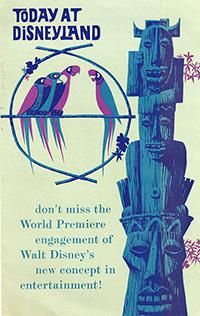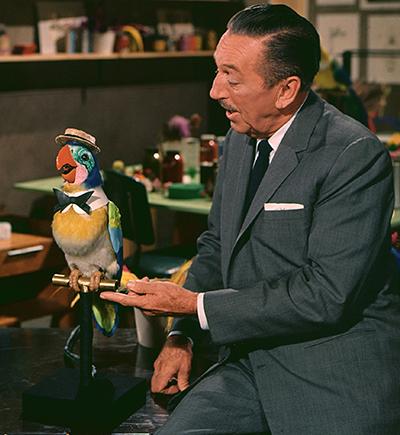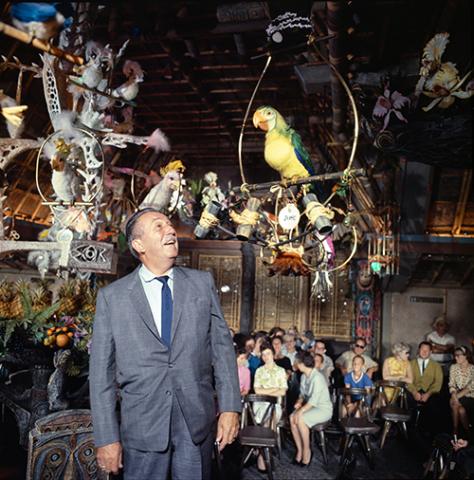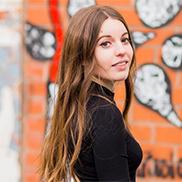
In June of 1963, Walt Disney’s Enchanted Tiki Room opened its doors for the very first time. The birds sang words, the flowers crooned, and the guests stared, awestruck, at the attraction’s feathered inhabitants.
Walt Disney’s Enchanted Tiki Room marked the first completed application of Audio-Animatronics® for Walt and his team, and gave WED Imagineers ample chance to experiment with the personalities of their creations. But why birds? And how did the much-loved emcee macaws—José, Michael, Pierre, and Fritz—come to be? Pay attention—it’s showtime…
“In the Tiki, Tiki, Tiki, Tiki, Tiki Room”
It’s difficult to think of the Enchanted Tiki Room as anything other than a show led by four avian masters of ceremony, but in actual fact, Walt had originally envisaged something quite different: a dining experience. Years later, Disney Legend Rolly Crump recalled Walt’s suggestion: “Walt called us in one day—this is when we were re-doing Adventureland; Adventureland was getting a whole facelift – and he said ‘I wanna do a little tea room, a little Tiki tea room.’ Just a little thing for… sandwiches and tea and coffee.”
It was Disney Legend John Hench who was asked to consider what a Tiki tea room might look like. During a meeting with Walt and Rolly Crump, John showed off his renderings—which featured real-life birds in cages above the restaurant’s diners. Walt was concerned about using real birds who might have “accidents”—not at all suitable for a restaurant environment.
Undeterred, John changed tack—“They’re stuffed!”—before suggesting sculpted birds which whistled and chirped. Another meeting attendee picked up on the idea, wondering whether these birds might tweet back and forth, as if in conversation with each other. Walt was intrigued.
Our Fine Feathered Friends
The next challenge was working out how these ‘birds’ might communicate. It was all very well in theory, but how would it work in practice?
Walt returned to the office, armed with ideas and a tiny mechanical bird he’d found on one of his trips. “It’s amazing that you can get such interesting movement from a very simple mechanism,” he observed—he was impressed by the antique invention and saw no reason why it couldn’t be improved. “He said ‘You know, they’ve done this in Europe for hundreds of years – if they’ve done this this well, we can do things now much better,’” explained Disney Legend Harriet Burns.
Walt wasn’t unfamiliar with the idea of producing moving, speaking figures – back in 1951, machinist Roger Broggie and sculptor Wathel Rogers had led a team in creating a nine-inch-tall dancing ‘man’, before the project had been put on hold in favor of focusing on Disneyland. But this time around, things were more complex. “Just as we had to learn to make our animated cartoons talk, we had to find a way to make [the Tiki Room] characters talk, too,” Walt later explained, “Now, to accomplish this we created a new type of animation—so new that we had to invent a new name for it: Audio-Animatronics.”

A Magnificent Production, Yet to Come
The ‘bird café’, as it became known, was starting to come together. But as the project progressed, Walt realized that pairing a restaurant with a show would create more problems than he’d originally expected—guests would naturally stop eating to watch the performance, and then would feel rushed to finish their meal in order to make room for the next viewing.
Walt made a bold decision: the Tiki building would become an attraction in its own right, and the performing birds would take center stage.
We’d Better Start the Show Rolling
Slowly but surely, it all began to fall into place. Imagineer Marc Davis began to create artwork for the Audio-Animatronics characters, while Harriet Burns and sculptor Blaine Gibson put together semi-realistic 3D models in order to consider what Disney’s ‘Tiki birds’ might look like.
Brothers Robert and Richard Sherman—already respected Disney songwriters – were invited to visit a mock-up of the attraction. Richard later remembered the surreal event: “Walt said ‘Okay, start it,’ and the next thing we know, the birds were coming down singing “Let’s All Sing Like the Birdies Sing,” the orchids were singing… and then the Tiki torches were chanting. When it was all over, nobody knew what it was…”
Animator and writer Larry Clemmons was present at the mock-up, and echoed the brothers’ sentiments: “Walt, what is this thing?” But Walt wasn’t worried: “That’s what you’re gonna tell us. You’re gonna write a song that explains it and Larry, you’re gonna write some gags to go with the song, ‘cause I wanna have fun with this thing.”
Robert and Richard were initially stumped, wondering what kind of a story they were expected to tell. But confusion soon turned to inspiration – what about an avian narrator? As Richard explained afterwards, a parrot in particular would make sense to guests, as it would not be a foreign concept for it to speak “language.” A moment later, Walt expanded on the idea: “Instead of one parrot emcee, we’ll have four, with French, Spanish, German and Irish accents.” And so, Pierre, José, Fritz and Michael were born…

Welcome to Our Tropical Hideaway
Creating the script for the newly-named Enchanted Tiki Roomwas a group effort, as legendary Disneyland performer Wally Boag confirmed: “Fulton [Burley, voice of Michael] and I and some of the others got together and we wrote the script around these four characters.” Larry Clemmons and Disney Legend Marty Sklar also contributed to the writing, composer George Bruns focused on the musical material, and the Sherman brothers created the calypso-inspired song, “The Tiki, Tiki, Tiki Room.” “It’s a team effort – we all did all of it,” Richard Sherman would later explain, “Walt would always say he believed in team efforts.”
The voices of the four emcee birds—initially dubbed ‘MacAudios’—were recorded in February of 1963. Spanish José’s playful personality was provided by Wally Boag, while Irish Michael was brought to life by the Golden Horseshoe Revue’s Fulton Burley. Rascal Pierre—a French macaw—was voiced by vocal artist Ernie Newton, and Thurl Ravenscroft, who would later go on to star as an iconic singing bust in Disneyland’s Haunted Mansion attraction, was German Fritz. “They all fell into it and had a great time… We always had a ball with these guys.” recalled Richard Sherman.
We’ve Been a Hit, and We Know You Adore Us
Almost 55 years later, Walt Disney’s Enchanted Tiki Room continues to captivate audiences both young and old. There’s no doubt that the humour and personality of our macaw hosts play a big part in repeatedly attracting Disneyland guests—and the fact that this classic piece of Imagineering effort is able to compete with newer, more technologically advanced attractions speaks volumes about its timeless charm and appeal. Even in 2018, José is still correct—these birds who sing words are a hit.
Now, are you ready? Let’s put on the show…

Sophie Jo is a writer and long-time Disney fan from England. Find her tweeting @sophiejowrites or happy-crying over it's a small world.
